When you choose earth-friendly bakeware for solar cooking, you'll benefit from superior heat distribution and chemical-free meal preparation. Materials like cast iron, ceramic, and stainless steel absorb and retain solar heat efficiently while ensuring your food stays free from harmful toxins like PFOA and BPA. These sustainable options last decades longer than conventional cookware, reducing waste and replacement costs. You'll save energy, minimize your environmental impact, and enjoy healthier meals cooked by the sun. The right eco-friendly bakeware transforms your solar cooking adventure into a safer, more sustainable experience, with even more advantages to discover.
Benefits of Sustainable Baking Pans
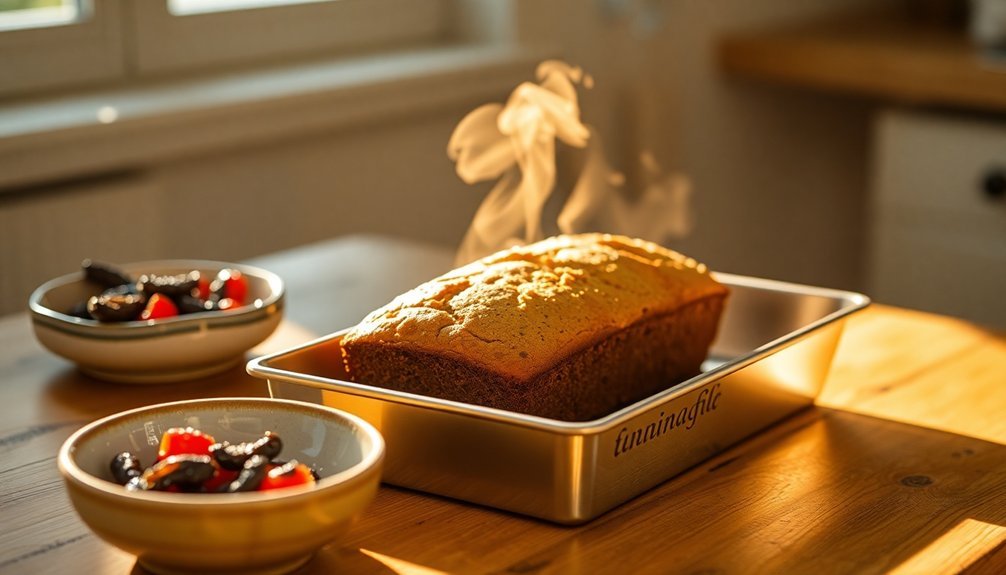
When considering the switch to sustainable bakeware, you'll find a wealth of benefits that extend far beyond the kitchen. By choosing materials like cast iron, stainless steel, or silicone, you're investing in cookware that's free from harmful chemicals like PFOA, BPA, and lead.
These eco-friendly options distribute heat more evenly, reducing your energy consumption while delivering better baking results. Modern sustainable options like PanSaver ECO™ utilize renewable rapeseed oil in their production, making them an environmentally responsible choice.
You'll appreciate how sustainable bakeware develops natural non-stick properties over time, eliminating the need for chemical coatings. The durability of these materials means you won't need frequent replacements, which saves money and reduces waste.
Plus, when your bakeware eventually reaches the end of its life, materials like cast iron are fully recyclable. With minimal packaging and production energy requirements, you're making a choice that benefits both your health and the environment.
Choosing Eco-Friendly Solar Cookware
While traditional bakeware serves its purpose, solar cookware offers a revolutionary approach to eco-friendly cooking that benefits both the environment and your health.
You'll find several types to choose from: panel cookers with reflective surfaces, box ovens that use heat-concentrating lenses, and parabolic cookers that focus sunlight onto a single spot.
When selecting your solar cookware, opt for black, insulated vessels that absorb heat efficiently. These specially designed pots help you pasteurize water and cook meals evenly while preserving nutrients. Using non-toxic materials like cast iron ensures your meals remain chemical-free and safe.
You'll save up to one ton of wood annually, reduce indoor air pollution, and lower your utility bills. Best of all, solar cookware is easy to maintain and clean.
For maximum versatility, consider portable options that you can take anywhere, allowing you to cook sustainably whether at home or outdoors.
Ceramic Options for Solar Cooking
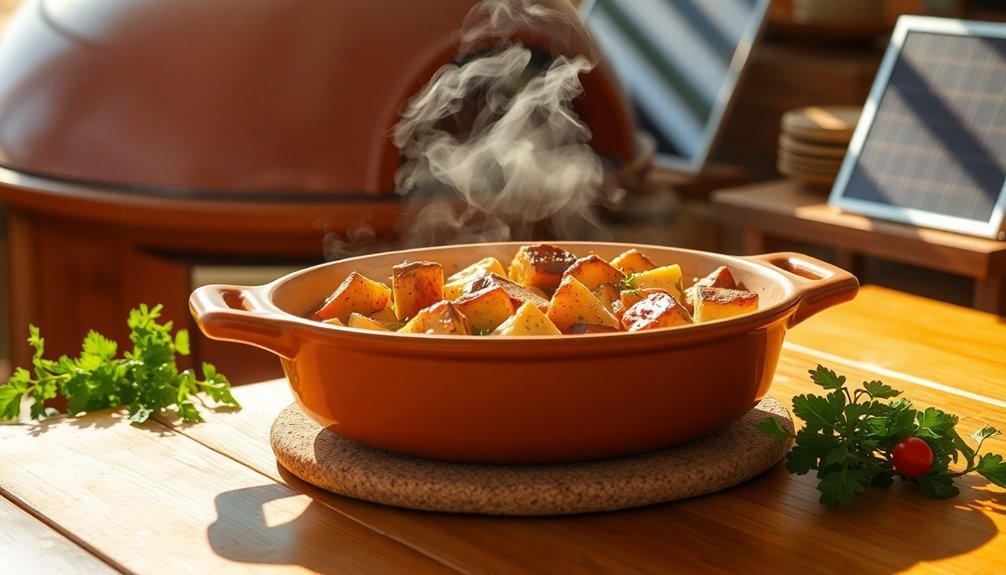
Ceramic cookware presents unique considerations for solar cooking enthusiasts. While you'll find these pots heat up more slowly than metal alternatives, they'll distribute heat evenly throughout your food, reducing the risk of burning.
You'll need to plan for longer cooking times and guarantee stable sunlight conditions when using ceramic vessels. Using proper pot holders and gloves is essential for safe handling during solar cooking.
To maximize your ceramic pot's performance, consider using dark-colored options, which absorb solar radiation more effectively. You can boost efficiency by preheating your pot and adding insulation around it.
While ceramic pots are heavier and more fragile than metal ones, they're non-toxic and align perfectly with eco-friendly cooking goals. If you're patient and careful with handling, ceramic cookware offers a safe, sustainable choice for your solar cooking adventures, particularly for slow-cooking dishes and baked goods.
Glass Versus Metal Pans
When choosing between glass and metal pans, you'll notice significant differences in heat retention, as metal cools quickly while glass stays hot long after leaving the oven.
You'll find metal pans easier to clean with simple soap and water, while glass pans might need extra scrubbing to remove baked-on residue. Chefs in professional kitchens prefer aluminum pans for their durability and practicality during busy service.
For maintenance, your metal pans require regular seasoning or coating checks, whereas glass pans need careful handling and storage to prevent chips and cracks.
Heat Retention Differences
Understanding the heat retention differences between glass and metal pans can greatly impact your baking results. Glass pans hold heat longer, which means your desserts will continue cooking even after you've removed them from the oven. In contrast, metal pans cool quickly, giving you more control over your final product.
| Feature | Glass Pans | Metal Pans |
|---|---|---|
| Heat Retention | Slow to cool | Quick to cool |
| Best Uses | Cobblers, crisps | Cookies, cakes |
| Temperature Needs | Reduce by 25°F | Standard recipe temp |
For best results with glass pans, you'll want to lower your oven temperature by 25°F and extend baking time by 5-10 minutes. Metal pans excel at even heating and browning, making them perfect for crispy crusts and uniform textures. They're especially effective when you're aiming for precise baking times and consistent results.
Cleaning And Maintenance Tips
Proper cleaning and maintenance routines can greatly extend the life of your bakeware, though glass and metal pans require different approaches.
Glass bakeware needs gentler handling to prevent thermal shock and scratches, while metal pans can withstand more rigorous cleaning methods and temperature changes.
When caring for your bakeware, remember these essential differences:
- Glass pans require non-scratch plastic or nylon scrubbers, while metal pans can handle tougher scouring pads.
- You'll need to protect glass from sudden temperature changes, but metal pans are more forgiving.
- Glass bakeware must be discarded if chipped or cracked, while metal pans often remain usable even with minor wear.
- Both types are dishwasher safe, but glass should always go on the top rack for protection.
Always check manufacturer guidelines for specific care instructions to maximize your bakeware's lifespan.
Heat Distribution in Solar Baking
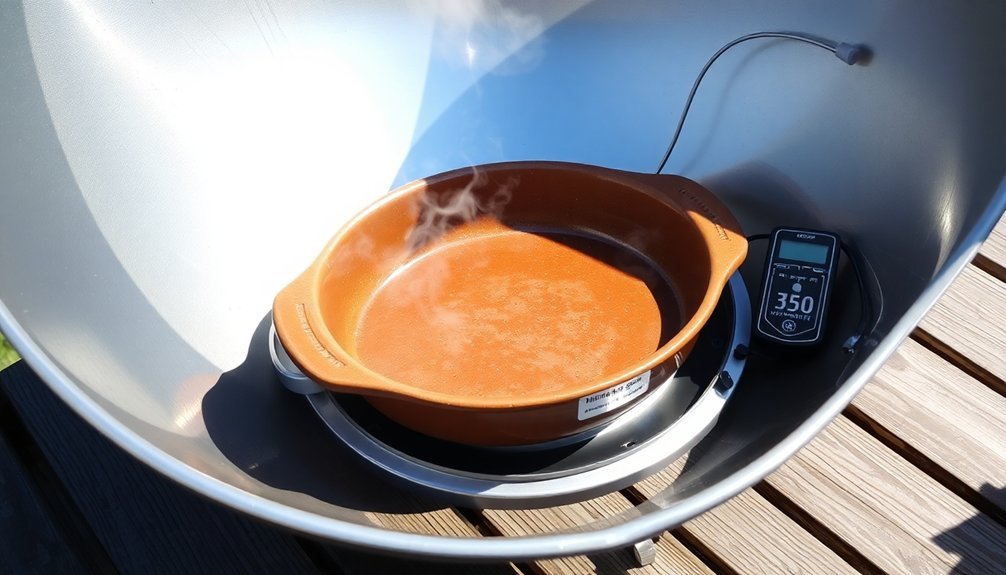
Successfully managing heat distribution in solar baking requires strategic positioning and careful attention to the sun's movements throughout the day.
You'll want to place your solar cooker on a level surface between 11 am and 3 pm when the sun's intensity peaks. Orient the front panel eastward for noon meals or westward for evening cooking, adjusting the position every 20 minutes to maintain direct sun exposure.
For ideal heat distribution, you'll need dark-colored pots with tight-fitting lids, positioned on a wire rack to create an essential air gap.
Layer your insulating materials strategically, using items like cotton balls or newspapers to trap heat effectively. Keep your reflectors clean and properly angled, moving them hourly to match the sun's path.
During windy conditions, stabilize your setup with stones or bricks.
Non-Toxic Solar Cookware Materials
When selecting cookware for solar cooking, choosing non-toxic materials guarantees both your safety and ideal cooking performance.
You'll find several excellent options that work effectively with solar energy while keeping your meals chemical-free.
- Carbon steel delivers quick heating and develops natural non-stick properties through seasoning, making it perfect for high-heat tasks in your solar cooker.
- Ceramic cookware heats evenly and retains heat well, though you'll want to verify it's free from heavy metals.
- Cast iron, especially enamel-coated versions, offers superior heat retention while preventing iron from leaching into your food.
- Natural clay cookware provides excellent heat distribution and is completely free from additives, making it one of the most environmentally conscious choices for your solar cooking needs.
Durability and Long-Term Value
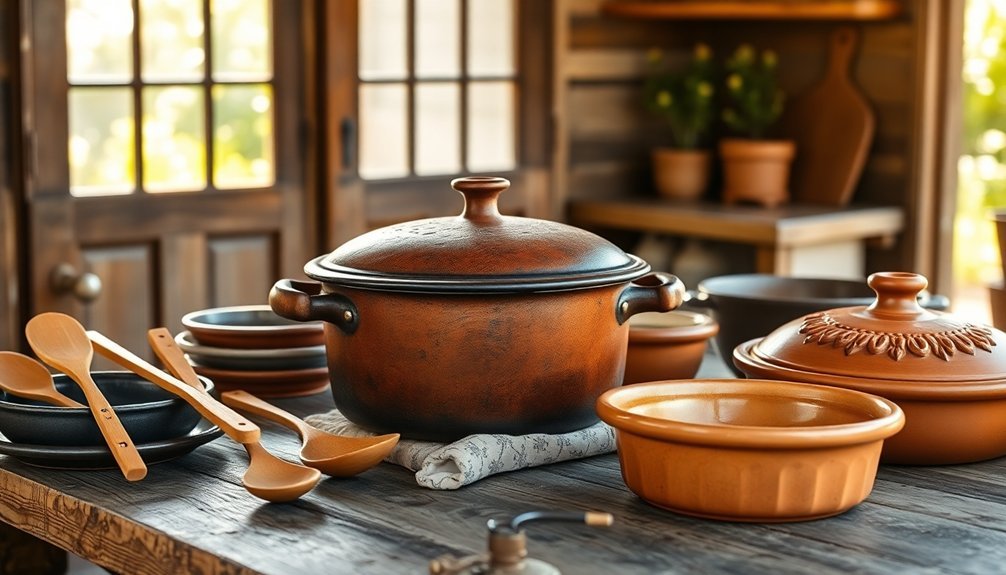
The lifespan of your eco-friendly bakeware greatly impacts both your wallet and the environment. When you invest in high-quality materials like cast iron, aluminized steel, or porcelain, you'll enjoy decades of reliable use with proper care. These durable options resist warping and maintain their non-stick properties far longer than conventional alternatives.
While you might pay more upfront for premium eco-friendly bakeware like Caraway's ceramic-coated pieces, you'll save money in the long run by avoiding frequent replacements. The robust construction guarantees even heat distribution and consistent results, while the non-toxic materials maintain their appearance with minimal discoloration.
Plus, these sustainable choices produce fewer carbon emissions during manufacturing and don't contain harmful forever chemicals, making them a smart investment for both your kitchen and the planet.
Energy-Efficient Solar Pan Features
Your solar pan's advanced heat absorption technology works like a high-efficiency solar panel, capturing and retaining thermal energy for ideal cooking performance.
The specialized coating and materials distribute heat naturally and evenly across the surface, similar to how monocrystalline panels maximize energy conversion.
You'll notice significant energy savings as these pans require less heat to maintain consistent temperatures, making them an eco-conscious choice for your kitchen.
Heat Absorption Technology Benefits
Smart engineering in solar bakeware maximizes heat absorption through several key features. The dark coloring and specialized surface coatings transform sunlight into usable heat energy, while the thin construction guarantees rapid, even heat distribution to your food.
When you're cooking with solar bakeware, you'll benefit from these heat-absorption innovations:
- Black or dark-colored surfaces capture nearly all available sunlight, converting it directly into cooking heat.
- Thin-walled construction transfers heat quickly and evenly, preventing hot spots that could burn your food.
- Specialized interior coatings enhance heat absorption while maintaining food safety standards.
- Strategic material selection guarantees maximum heat capture while minimizing energy waste.
These features work together to create an efficient cooking surface that harnesses the sun's power effectively, reducing your reliance on conventional energy sources.
Natural Distribution Properties
Natural energy distribution in solar pans relies heavily on advanced material configurations and specialized design elements. You'll find these pans maximize solar absorption similar to high-efficiency monocrystalline panels, delivering consistent heat distribution for your outdoor cooking needs.
| Feature | Benefit | Performance |
|---|---|---|
| Black Surface | 22% Higher Heat Capture | Like Premium Solar Panels |
| Heat Zones | Even Temperature Control | Matches Mono Panel Efficiency |
| Material Design | Zero Energy Loss | Mimics 400W Panel Output |
The pan's distribution system works similarly to top-tier solar technology, utilizing the same principles that make monocrystalline panels superior in warm conditions. You're getting the environmental benefits of solar cooking while enjoying the precision of professional bakeware, as the pan's surface maintains consistent temperatures throughout your cooking process.
Waste Reduction Through Better Materials
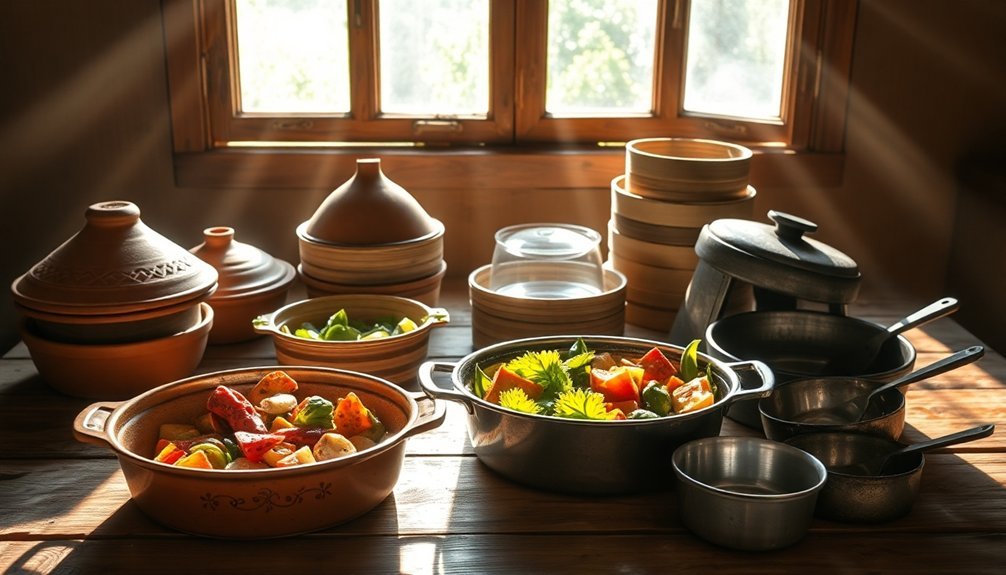
When choosing sustainable bakeware, eco-friendly materials play a crucial role in reducing waste and environmental impact.
Today's eco-conscious manufacturers offer innovative solutions using renewable resources like sugarcane, bamboo, and wheat to create durable, biodegradable products.
- Your compostable bakeware will break down in 60-90 days, leaving no harmful residue.
- You'll eliminate tree pulp usage by selecting products made from agricultural byproducts.
- You can opt for clear lids made from 100% recycled PET plastic.
- You'll reduce waste with versatile, reusable options like silicone and stainless steel.
These sustainable materials don't just benefit the environment – they're designed for peak baking performance.
Safe Solar Cooking Methods
Safe solar cooking requires precise temperature control and careful timing to guarantee food safety and ideal results. You'll need to maintain temperatures between 200-300°F using a digital probe thermometer, ensuring meats reach proper internal temperatures: 145°F for whole cuts, 160°F for ground meats, and 165°F for poultry.
Plan your cooking between 11 AM and 3 PM when sunlight's strongest, and adjust your oven's position every 1-2 hours to follow the sun. Quick items like eggs need less than an hour, while whole chickens take about 3 hours.
Remember to stir liquids and rotate solid foods every 10-15 minutes for even cooking. Keep raw foods separate from cooked ones, use clean, dark-colored cookware, and maintain proper hygiene to prevent cross-contamination.
When not in use, store your oven's mirror face-down to protect it.
Sustainable Material Comparison Chart
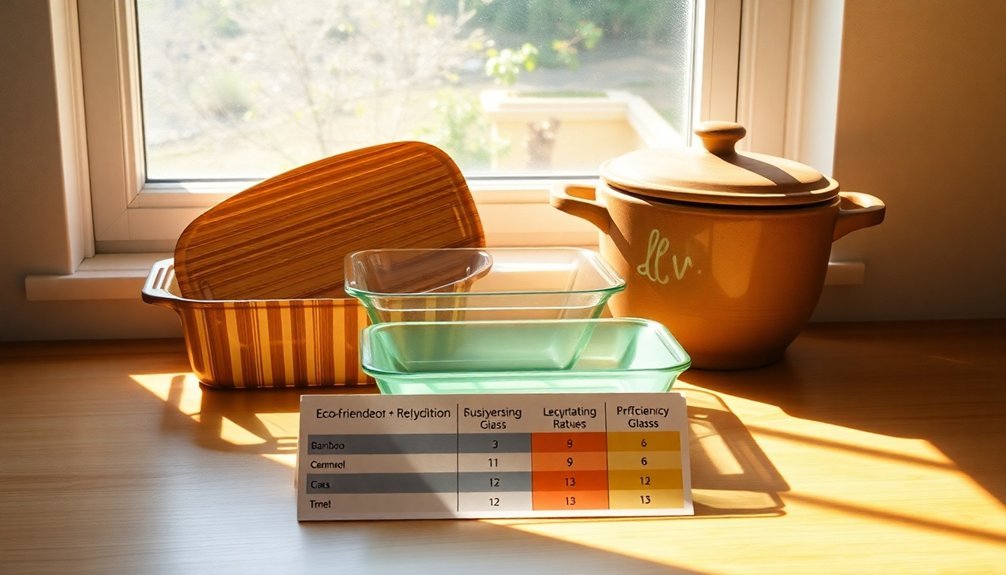
When you're choosing sustainable bakeware, you'll find distinct advantages in ceramic, stainless steel, glass, and silicone options, each offering unique properties from scratch resistance to heat distribution.
Your environmental impact varies greatly among materials, with ceramic and glass being 100% recyclable, while stainless steel and silicone excel in durability and reusability.
Though sustainable bakeware often requires a higher upfront investment, you'll save money over time through their superior longevity and energy-efficient cooking properties.
Popular Material Properties
Four primary sustainable materials dominate today's eco-friendly bakeware market: ceramic, stainless steel, cast iron, and silicone. Each material offers unique properties that can enhance your cooking experience while protecting the environment.
- Ceramic bakeware delivers chemical-free cooking with natural non-stick properties, making it perfect for everything from microwave to BBQ use while being fully recyclable.
- Stainless steel's durability and non-reactive surface guarantee even heating and long-lasting performance without chemical leaching.
- Cast iron stands out for its superior heat retention and multi-generational durability, developing a natural non-stick surface when properly seasoned.
- Silicone provides flexibility and lightweight handling, with heat resistance up to 450°F and freedom from harmful chemicals like BPA and PFOA, making it ideal for specialized baking shapes.
Environmental Impact Assessment
Understanding the environmental footprint of different bakeware materials helps you make informed decisions for both cooking and conservation.
When you're choosing bakeware, consider how nonstick coatings harm the environment during production and disposal. These coatings contain PFAS that contaminate water, soil, and air, while their manufacturing process releases greenhouse gases.
You'll also find that nonstick pans have shorter lifespans and create more landfill waste.
Instead, opt for stainless steel or cast iron alternatives. They're durable, recyclable, and won't release toxic chemicals during use.
Cast iron can last for generations with proper care, while stainless steel can be made from and returned to recycled materials.
Long-Term Cost Benefits
Making smart investments in sustainable bakeware can greatly reduce your long-term costs while protecting the environment. When comparing ceramic, stainless steel, and recycled material options, you'll find they all offer impressive durability and energy efficiency that translate to significant savings over time.
- Your initial investment pays off through decades of use, as these materials don't require frequent replacement like conventional bakeware.
- You'll save on cooking costs since these materials distribute heat evenly, reducing energy consumption and cooking time.
- There's no need to buy non-stick sprays or special cleaning products, as these materials are naturally non-stick and easy to maintain.
- Many sustainable brands offer lifetime warranties and replacement programs, ensuring you'll never need to purchase replacements again.
Environmental Impact of Cookware Choices
Your choice of cookware can have a significant environmental impact throughout its lifecycle, from resource extraction to disposal.
While stainless steel and cast iron require energy-intensive production, they're highly durable and can last for generations, reducing the need for frequent replacements. You'll find that both materials are recyclable, making them more sustainable long-term options.
Be cautious with non-stick and ceramic coatings, as conventional versions often contain toxic chemicals that can leach into food and release harmful fumes when heated.
While aluminum and copper conduct heat efficiently, their production generates substantial CO2 emissions and toxic waste.
If you're prioritizing eco-friendliness, opt for cookware made from recycled stainless steel or well-maintained cast iron, as these materials offer the best balance of durability and environmental responsibility.
Maximizing Solar Cooking Performance
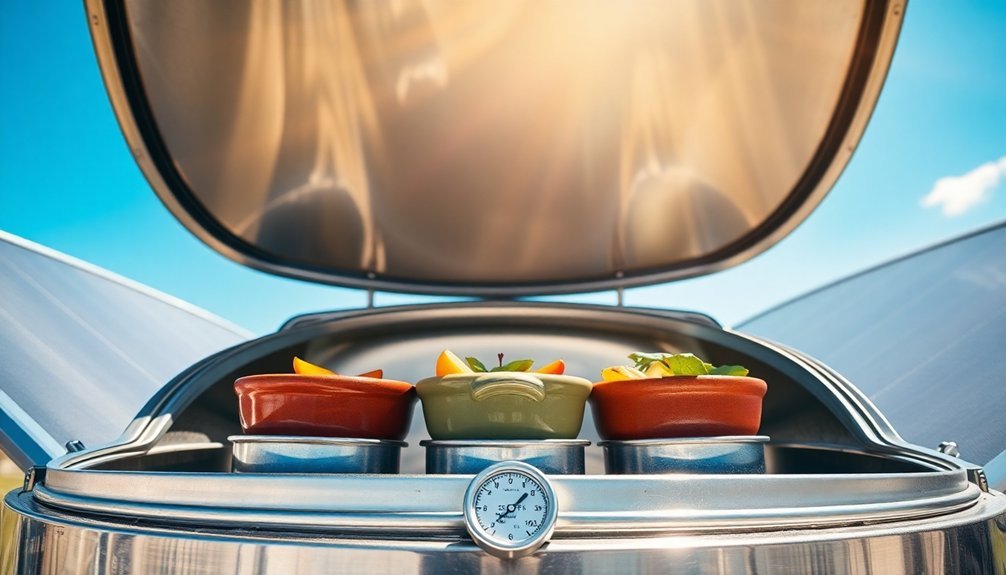
When harnessing solar energy for cooking, several key factors work together to maximize performance. By understanding these elements, you'll achieve better results with your solar cooking setup.
- Choose matte black cookware and surfaces to absorb maximum sunlight – they're considerably more effective than lighter colors or shiny materials.
- Install proper insulation using materials like cardboard, cotton, or foam to trap heat and maintain consistent cooking temperatures.
- Position reflective surfaces strategically to direct additional sunlight toward your cooking area, especially during non-peak hours.
- Use a transparent lid or glazing to create a greenhouse effect while ensuring your cooker has quality seals to retain moisture.
Remember to align your cooker's longer dimension east to west and make minimal adjustments during cooking to maintain ideal sun exposure.
Frequently Asked Questions
Can I Use My Earth-Friendly Bakeware on Both Solar Ovens and Conventional Stoves?
Yes, you can use most earth-friendly bakeware on both solar and conventional stoves. Your aluminum and enamel-coated pots work efficiently in both, while cast iron performs better on conventional stoves but still functions in solar ovens.
How Do I Properly Clean and Maintain Eco-Friendly Solar Bakeware?
You'll want to hand wash your eco-friendly solar bakeware with mild soap and warm water. Don't use harsh scrubbers or detergents. Dry thoroughly after cleaning and store in a cool, dry place to prevent damage.
Are Dark-Colored Sustainable Pans Better for Solar Cooking Than Light Ones?
Yes, you'll get better results with dark-colored pans for solar cooking. They absorb more heat energy than light ones, cook food faster, and maintain consistent temperatures. Dark surfaces trap sunlight more efficiently.
What's the Average Lifespan of Earth-Friendly Solar Cookware Compared to Conventional Options?
Your earth-friendly solar cookware can last 10+ years with proper care, outlasting conventional non-stick pans that typically need replacement every 2-3 years. With maintenance, solar cookers match traditional stainless steel's longevity.
Can Sustainable Bakeware Withstand Extreme Temperature Changes in Solar Cooking Conditions?
You'll find ceramic and cast iron bakeware excel in solar cooking, handling extreme temperature shifts well. Ceramic withstands up to 500°F, while cast iron manages 1000°F, both offering superior heat retention and durability.
In Summary
You'll make a significant impact by choosing earth-friendly bakeware for your solar cooking adventures. Whether you opt for ceramic, glass, or sustainable metal options, your choice helps reduce environmental impact while ensuring ideal heat distribution. By selecting the right materials, you're not just cooking with the sun – you're contributing to a healthier planet. Make your solar cooking experience count with sustainable cookware choices.
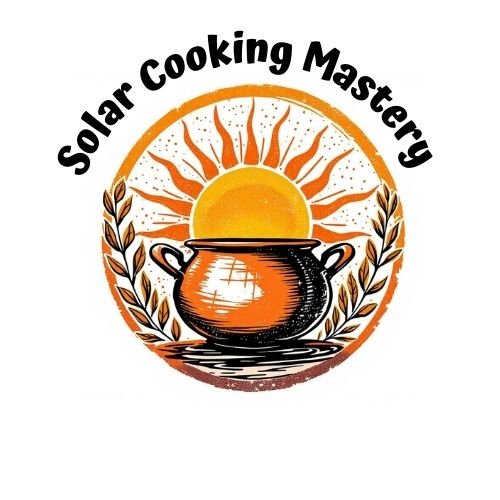
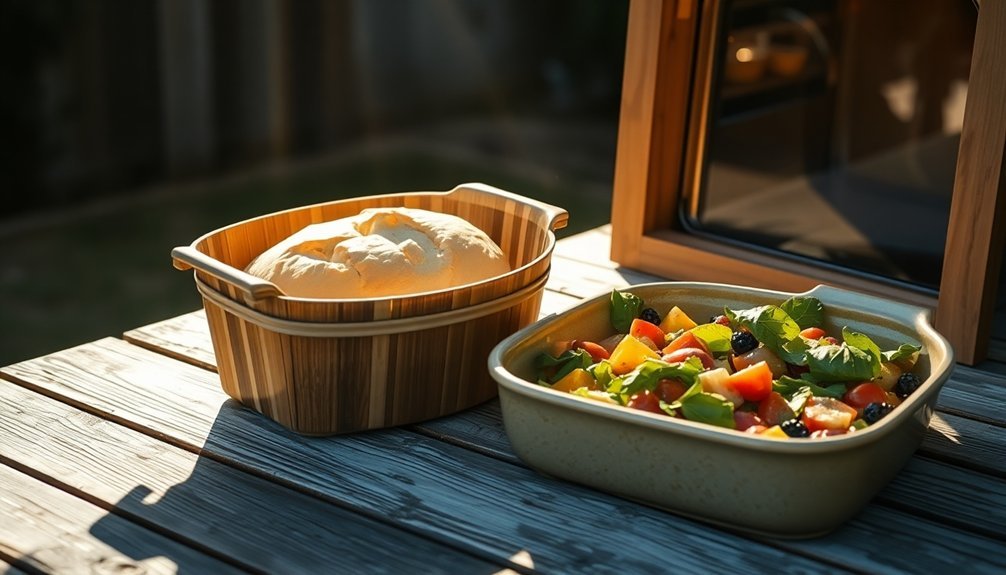
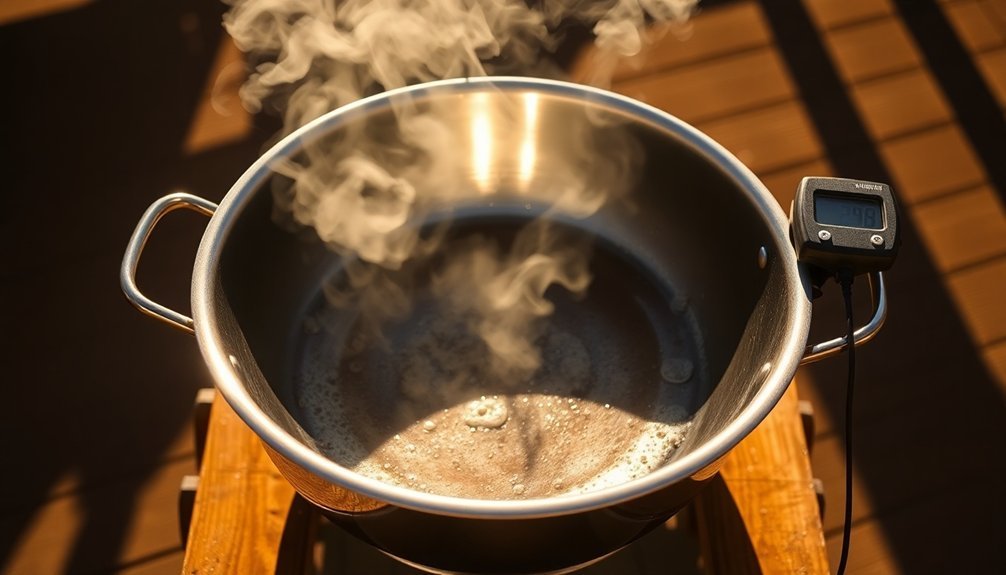
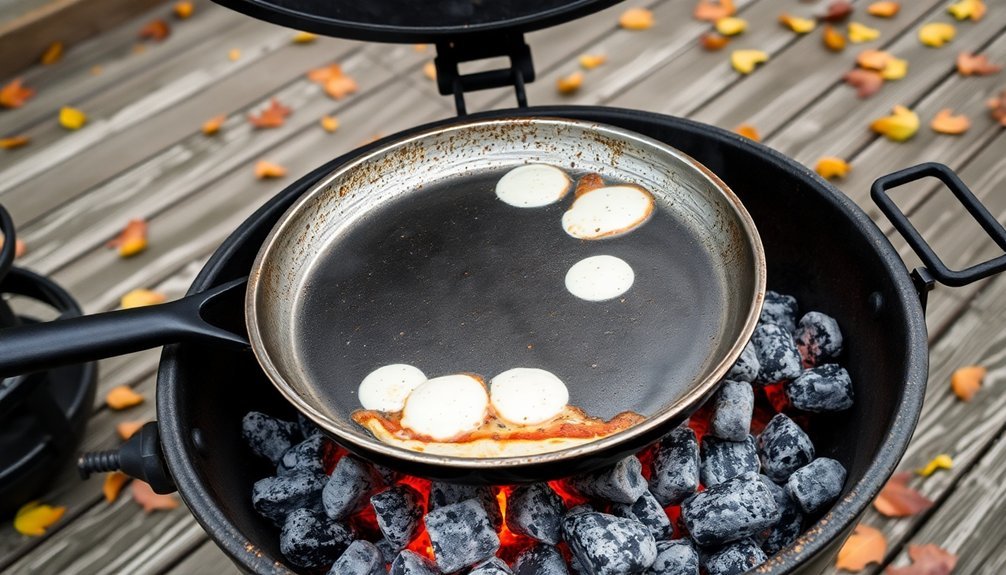
Leave a Reply